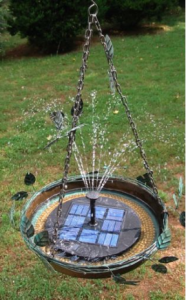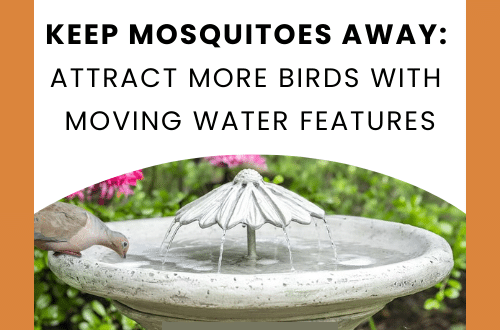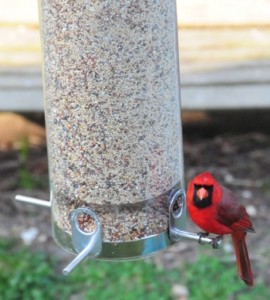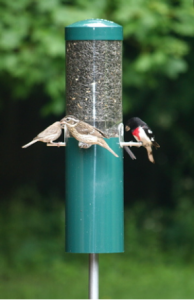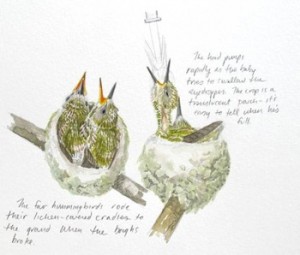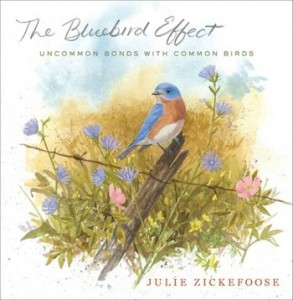-
keep water moving… even in a hanging bird bath
An essential element for life, like the air we breathe, water is a simple, inexpensive way to entice more birds to your yard. Many species who don’t visit feeders or use nest boxes will frequent a bird bath. The only responsibility with a pedestal, ground, or hanging bird bath is keeping the water fresh, not only for birds, but for other health reasons too.
Recently the New York Times reported that in the Long Island area, the health department has actually been checking residents’ birdbaths and imposing fines for dirty bath water… no kidding! Four people have received hefty fines too-as the city is taking the situation quite seriously. The reason is stagnant water and the fear is the dreaded West Nile Virus spread by mosquitoes.
It doesn’t matter what kind of birdbath you have, or may be planning to purchase in the future. There’s a simple solution to avoid stagnant or standing water, and that is to keep it moving! Known fact: Mosquitoes can not lay eggs in moving water. Bath accessories like Water Wigglers, fountains, bird bath drippers, and leaf misters all keep water moving… and the birds absolutely love them! These create visual magnets for avian friends, and they run on batteries, solar power, or from the garden hose. Plus they’re simple to install and keep bath water cleaner longer.
Take a plastic, gallon milk jug and create your own dripper that works great, even in a hanging bird bath. Simple to do and very inexpensive, pierce a pin hole in the bottom corner of the jug. Secure the jug (through the handle) to a sturdy branch above the bath using rope, wire, or even a large S-hook. One gallon of water dripping through a tiny pin hole will last for days! Simply refill the jug for continued use. The movement will catch birds’ attention, and keep mosquitoes from laying their eggs. It’s a win-win situation for all!
-
feature-rich, classic tube bird feeder hangs or pole-mounts
You know those plastic feeders we always see at discount and “big-box” stores, they’re inexpensive and will serve the purpose… for a little while anyway! But soon the cheap plastic clouds and yellows, perches break, and heaven forbid if a squirrel should get hold of your new tube bird feeder… it’s a goner 🙁
Well, here’s a tube feeder with quality to last a lifetime, squirrel-proof features (sans the ugly cage), and twenty years of proven performance. The Classic Feeder is designed with a built-in squirrel baffle to foil the pesky critters permanently. With hanging or pole-mount options, it’s too tall and too wide for squirrels to reach the seed ports from the top on the hanging feeder, and from the bottom of the pole-mounted feeder.
Poly-carbonate casing, with a baked enamel lid and baffle, plus stainless steel perches, all promise this tube bird feeder will be around for many years of use for feathered friends. There’s even an attractive weather guard to protect seed from the elements, and it won’t hinder your views of dining birds either.
Ample perches provide easy access for many birds who aren’t commonly seen at tube bird feeders, and the large capacity cavity means less filling and more time watching. Even the pole is included on the post-mounted version! Accommodating black oil sunflower, or a bevy of other seed mixes, the Classic Feeder is truly a shining gem among all those tube bird feeders out there!
-
Highly Recommended Birding Book-The Bluebird Effect
Watercolors, life sketches and graceful writing in a spectacular literary and artistic tribute to birds
Baby hummingbirds need to be fed every twenty minutes, from predawn darkness to bedtime. Have you ever had to do anything every twenty minutes? You turn around and it’s time to do it again.
Three nestling hummingbirds grew up and, when released, buzzed around the yard behind the only mother they knew until it was time to migrate to Central America in September. The following April, all three returned to her Ohio doorstep, strong, fit, and wild, but with their “uncommon bonds” to Julie intact..
“It often begins,” she says, “with a phone call from someone who’s found a baby bird and wants to bring it over.” Julie Zickefoose is a licensed wildlife rehabilitator who has been answering such calls since 1981.
Bluebird Hatchlings Her remarkable book, The Bluebird Effect: Uncommon Bonds with Common Birds offers an intimate look into her experiences as a wildlife rehabilitator.. But it is much more than a collection of bird stories. Each of the 25 species of birds Julie profiles is brought to vibrant, intelligent life, with a wealth of natural history and behavioral observation that only someone who’s lived with birds could supply. Delicate watercolor vignettes and deft life sketches by the author create a visual feast on every page. There is no other North American writer who combines Zickefoose’s unique skill set to produce the lavishly illustrated page-turners for which she’s become justly famous. In high demand as a speaker, the biologist, writer and painter Zickefoose has been called “the greatest triple threat in natural history since Roger Tory Peterson.”
The Bluebird Effect is about the change that’s set in motion when you drop everything to help a bird, and are in turned welcomed into its world. “I don’t consider myself an expert in bird behavior,” Zickefoose says. “I’m a faithful recorder and a good storyteller, but the birds will always be my teachers. They’re the only experts.”
Julie Zickefoose, a National Public Radio commentator and a Contributing Editor to Bird Watcher’s Digest, lives outside Marietta, Ohio. Her lucid and deeply moving writing combines a childlike sense of wonder with the seasoned wisdom of a lifelong naturalist. It’s the interaction between birds and humans that fascinates her most.. “I live for the moment when my gaze meets a bird’s—that exchange of awareness of the ‘who’ in each of us, the spark of understanding leaping from the bright bead of its eye to mine.”
Zickefoose began illustrating natural history subjects as a freshman at Harvard in 1976. After a six-year stint as a field biologist for The Nature Conservancy, she turned to freelance writing and art. Since then, her work has been featured in Bird Watcher’s Digest, on NPR’s All Things Considered, and her book of illustrated essays Letters from Eden: A Year at Home, In the Woods. Her web site, www.juliezickefoose.com, has galleries of her art, writing selections, and a popular blog rife with her photography, paintings and direct observations of nature. http://juliezickefoose.blogspot.com
She and her husband Bill Thompson III, editor of Bird Watcher’s Digest, live with their two children on 80 acres in Washington County in a house with extensive gardens, an art studio and a 42-foot bird-watching tower. 185 species of birds and 78 butterfly species have graced their sanctuary to date.
The Bluebird Effect:
Uncommon Bonds with Common Birds
Julie ZickefooseList $28..00
Publisher: Houghton Mifflin
ISBN: 978-0-547-00309-2
Format: Hardcover, 8.5 X 8.5, 384 pp, 320 illustrations, most in full color
Official Publication Date: March 20, 2012
Category: Natural HistoryAvailable wherever books are sold. For more information visit www.juliezickefoose.com
Each of the twenty-five chapters covers her experiences with a different bird species, delving into its individual natural history, quirks and, for lack of a better word, “personality.” Nearly every page showcases Zickefoose’s stunning watercolor paintings and pencil drawings. Her unique talent is synthesis: tying her observations of birds into a larger context and meaning; revealing what is astonishing about events many might not even notice.
The Bluebird Effect is about what happens when, by virtue of raising it when it’s orphaned or helping it when it’s hurt, one is taken into the confidence of a wild bird. It’s about the unexpected mental and emotional capacities of birds, especially songbirds, which we tend to vastly underestimate. Everyone knows that crows and parrots are intelligent, but have you ever thought about the minds of hummingbirds? Julie Zickefoose has a unique perspective, having been mother to six. And multiple chimney swifts, cedar waxwings, mourning doves, cardinals and rose-breasted grosbeaks, to name a few. Join her for an intimate, eye-opening look at the rich mental and emotional landscape of birds.
What People Are SayingOprah’s Book Club “Book of the Week”
“We’ve been knocked to our knees by the illustrated essay collection, The Bluebird Effect… She not only endows each bird with human-like personality traits, enough… to bond you with her feathered companions, but also offers up some thoughtful commentary on our human inner lives, such as (her thoughts) while (rescuing) a family of swallows from a rat snake: ‘I’ve never much liked catching large snakes over my head while standing on a ladder. Maybe there’s a word for that little cluster of phobias. Stepnophidiophobia works; I just coined it. If what one is frightened of is truly, ridiculously scary, is it fair to call one’s fear a phobia?’…One doesn’t have to care all that much about birds to get sucked into her dreamy illustrated stories…”
– Oprah.com April 3-6, 2012“Birders will appreciate her meticulous observations and devotion to the avian world, but anyone who’s ever considered hanging a birdfeeder is likely to be mesmerized by the sensuous, precise prose as well as Zickefoose’s vivid portraits of scrawny, fluffy phoebe chicks, a self-possessed hummingbird perched on a clothesline, dwarfed by the surrounding clothespins, and orioles migrating by moonlight. Readers will be astounded by the drama and intelligence fluttering in their backyards.”
–Publishers Weekly“Beguiling stories from a naturalist’s life with backyard birds…Describing her songbirds with a delicacy of words and brush strokes, Zickefoose makes learning about birds seem like the adventure of a lifetime. A wonderful treat for birders.”
–Kirkus (The World’s Toughest Book Critics)“A wonderful amalgam of nature writing and memoir…This lovely book is one to savor slowly, admiring both writing and artistry.”
–Booklist, starred review

